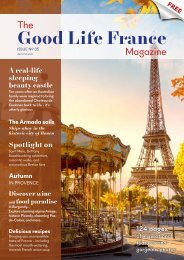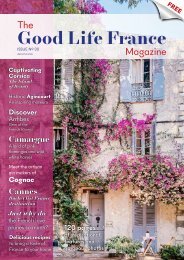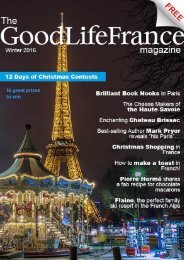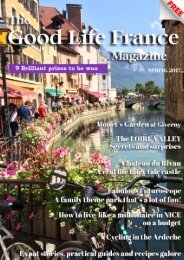Summer 2024
Full of fabulous features, fantastic photos - inspiring, entertaining and informative. Culture and history, destination guides including Paris, Brittany, Toulouse, Troyes, Alsace-Lorraine, Champagne and more. Discover brilliant city, country, seaside and gourmet breaks. Truly scrumptious recipes to make at home. And much, much more. Bringing France to you - wherever you are.
Full of fabulous features, fantastic photos - inspiring, entertaining and informative. Culture and history, destination guides including Paris, Brittany, Toulouse, Troyes, Alsace-Lorraine, Champagne and more. Discover brilliant city, country, seaside and gourmet breaks. Truly scrumptious recipes to make at home. And much, much more. Bringing France to you - wherever you are.
You also want an ePaper? Increase the reach of your titles
YUMPU automatically turns print PDFs into web optimized ePapers that Google loves.
Gillian Thornton explores the pretty town of Figeac and the surrounding<br />
countryside of the glorious Célé Valley…<br />
Spotlight on<br />
FIGEAC, LOT<br />
A modest market town in rural Lot isn’t the first<br />
place you might expect to find connections<br />
between Napoleon Bonaparte, Ancient Egypt<br />
and the British Museum. But thanks to the<br />
inquisitive mind and dogged determination of<br />
19 th century linguist and puzzle supremo Jean-<br />
François Champollion, the medieval town of<br />
Figeac in Occitanie provides a link to all three.<br />
This buzzing town of around 10,000<br />
inhabitants lies just north of the Lot river in<br />
the valley of the Célé, the surrounding area<br />
of Grand Figeac designated a Pays d’Art<br />
et d’Histoire. With its wealth of medieval<br />
buildings, Figeac is a gem for heritage fans,<br />
but it has Champollion to thank for its place<br />
on the world stage.<br />
granite covering most of the floor. A dignified<br />
celebration of Figeac’s most famous son.<br />
In 1798, Napoleon launched a campaign<br />
in Egypt and Syria to defend French trade<br />
interests and carry out scientific research.<br />
But when the British Navy put paid to the<br />
Emperor’s dreams of a Middle Eastern empire,<br />
the collection of Egyptian antiquities amassed<br />
by his scientists was signed over to the British,<br />
including the Rosetta Stone that now stands in<br />
the British Museum in London.<br />
Once part of a much larger stone tablet,<br />
this precious fragment was engraved with<br />
three incomplete texts in different scripts,<br />
but nobody knew what they said. Academics<br />
puzzled for years, but it was more than 20<br />
years before the youngest son of a Figeac<br />
bookseller eventually cracked the code. Born<br />
in 1790, Jean-François Champollion had<br />
left home at 11 to live with his older brother<br />
in Grenoble, where he quickly developed a<br />
passion for Middle Eastern languages, and at<br />
17, he moved to Paris, determined to decipher<br />
the mysterious tablet.<br />
Place des Ecritures from the upper garden<br />
I’m looking down from a high-level garden<br />
in the town centre onto a small pedestrian<br />
square surrounded by stone buildings. Little<br />
more than a courtyard, the Place des Ecritures<br />
is empty apart from an irregular slab of black<br />
Musée Champollion - Les écritures du Monde Lot Tourisme © C. Asquier<br />
Figeac 30 | The centre Good © Lot Life Tourisme, FranceTeddy Verneuil<br />
The Good Life France | 31

















